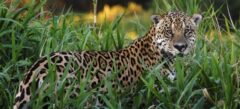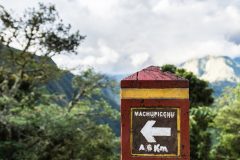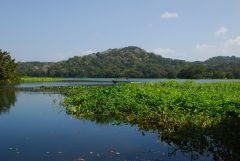Verity of Antarctica

Verity Allan, former travel consultant for Journey Latin America, relives her epic voyage to the White Continent.
I felt a certain amount of trepidation mixed with excitement as our small plane touched down on King George Island in the South Shetlands. After all, it was here that I would embark on an expedition relatively few people had ever had the privilege of taking.
From South America you can reach Antarctica in one of two ways – either by boat, setting sail from Ushuaia in Argentina and crossing the notorious Drake’s Passage, or via the relatively new route I had chosen. This involves taking a plane, specially adapted to landings on short runways, from Punta Arenas in Chile to the South Shetlands and then meeting your boat at the Chilean ‘Frei’ base.
As we made the short walk through knee-deep snow to the zodiacs that would take us to our expedition boat, I was overwhelmingly grateful for the four layers of clothing I was wearing. Every part of me was covered and yet I could still feel how cold it was – a comparatively mild minus 18˚C in the wind. Well, it was their summer after all! Appropriate clothing is absolutely essential and we had been loaned hard grip boots to use before leaving Punta Arenas.
Once onboard what would be our floating home for the next six days, it struck me how comfortable and warm it was considering the contrasting environment outside. I had my own cabin with private bathroom. Communal areas were welcoming with biscuits and hot drinks laid out at the bar at any time and an open bridge policy was enforced, meaning that you could go up to the bridge whenever you chose and gaze incredulously at the landscape passing by. It was on one such occasion that our group spotted two whales – a mother and her calf, swimming alongside the boat. Every few minutes you could see them diving down to the deep with their great tails held up in the air, catching the sunlight before disappearing into the glittering Antarctic waters. You couldn’t help but wonder how a mammal so huge could possibly be so graceful.
One of our first landings was at Ardley Island, an area specially protected by the Antarctic Treaty due to its biological interest. It was special for me, however, because it was here I saw my first Gentoo penguin chicks. It is absolutely incredible to be able to stand so close to a penguin as it huddles over a chick to shelter it from the harsh Antarctic winds – the success of the species in such a harsh environment is truly fascinating to witness.
Our next stop the following morning was Mikkenen Harbour. This used to be a small whaling station, but when we landed here we were met by a vigilant Weddell seal. I was surprised at its size and the expressiveness of its features – although while it looked very relaxed and content we were reminded not to go too close. Further south that afternoon, we also saw a leopard seal decadently lying on an iceberg as we took photos, and from its appearance you could have been forgiven for thinking it was enjoying its photo shoot!
Our charted route had been to sail down to Neumeyer Channel to reach Port Lockroy but with Antarctic weather conditions changing dramatically and constantly we all had to be prepared for a change of plan. Luckily, as we sailed through the channel the experienced crew were all surprised by the ice-free sailing and soon we were landing on Port Lockroy – one of the places that I had been most excited to see. This used to be a renowned British research station but now boasts the title of the world’s most southerly museum, gift shop and post office! The station is manned by four British girls who, inspiringly, volunteer to stay out there for four month stints with very limited facilities and only the odd passing expedition ship and each other for company. I was able to chat to one of the girls and find out a bit more about why she had volunteered, and was intrigued to find out that she had come from the hustle and bustle of London to this almost deserted outpost for a challenge and to learn about a more basic way of life. And basic it certainly was – we heard they were only allowed one shower per week!
Having dispatched our postcards a little dubiously at the Post Office, we left and continued further south along the Lemaire channel. The 7-mile crossing is narrow with sheer cliffs on either side, offering incredible scenery. The sun was shining, glinting against the walls of ice and off the sea, giving the voyage a magical quality. It is easy to see why the very early seafarers were almost superstitious about this little-touched continent.
We finally reached Petermann Island, the southernmost point on our trip at at 65° 10’5, 64° 10’ W. Here we were treated to the sight of a breeding colony of Adelie penguins, some chinstrap penguins and a small blue-eyed cormorant colony. Our small group stood with the Adelies for quite some time, fascinated by their fervent collection of stones for their nests. Our guide told us that stones are the penguin equivalent of currency so the more pebbles they can gather the more status that have. They often tried to steal each other’s pebbles which resulted in penguin scuffles – another incredible ritual to watch.
That day had been well and truly spectacular, and to mark the occasion our crew had prepared an open-air barbeque for us. There we were, moored in an old crater lake with a gentle fall of snow, out on deck enjoying a feast of delicious meats, salads, pastas and some lovely Chilean wine. It was so wonderfully surreal and just one example amongst many of how the crew and staff went out of their way to make sure we enjoyed ourselves.
Finally, on December 14th, we made a landing on the Antarctic continent itself at Paradise Bay. We landed at Almirante Brown Station, a closed Argentine Base and had some champagne to toast our landing. Of course we were not the first explorers to make it here but it certainly felt like it! We were able to make a long uphill hike to a viewpoint overlooking breathtaking scenery and it was like the whole continent lay before us. Had Shackleton been here when he came so long ago, and had he experienced the same humbling feeling of awe? It was impossible not to feel overwhelmed by the beauty and remoteness of our surroundings.
To preserve energy and avoid the steep walk down, our guide showed us a novel way of getting down the hill – on our backs! The snow was so compact you could lie on it (with your waterproof jacket on, of course) and, with the help of an initial push, just slide right down the steep hill to our boat – getting around like a penguin can be great fun!
Another highlight of our trip for me was our landing at Deception Island in Whalers’ Bay. The island is still an active volcano and the only one which can be accessed by ships through its open caldera. There are so many remains here to testify to the island’s past industriousness – workers’ houses, whaling stations and 2 huge metal drums for melting the whale fat in, all in the name of money. These enormous structures were in sharp contrast to the bleak grey landscape – from the grey hills behind the bay to the grey tin of the roofs of the abandoned house and the dark grey wood of the crosses marking the graves of the whalers who once lived and worked in this desolate environment. I hadn’t realised that this whaling activity carried on here up until the 1970s, when a volcanic eruption finally ceased productivity.
We navigated back to our starting point ready for our return flight to Chile but Antarctica had one final surprise for us. The weather had changed so dramatically that we couldn’t depart that day: the plane would not be able to land in the South Shetland Islands. However, onboard the comfortable ship, being looked after so well and in such a special place I found that I didn’t really mind having an extra night here! When we finally did catch our flight back to Chile the next day, I found myself thinking, not for the first time, how much of an achievement it was for the early explorers like Amundsen, Shackleton and Scott, to not only make it to this rugged and harsh part of the world but also to have survived at least one expedition. They had no flight to take them safely home, no clothes providing up-to-the-minute thermal technology, no computerised weather maps to help plan their routes – in fact with not very much at all, they had come so far and achieved so much.
...Oh and the postcards made it back to England about three weeks after I did, much to the delight of my family!
Tailor-made holidays
Flexible, custom-made holidays to Latin America created to match your exact requirements: our tailor-made itineraries are as unique as the clients for whom they are designed.
Design my tripPapagaio
Your edit for Latin American inspiration
Our exciting range of articles on Latin America explore everything from iconic destinations and lesser-known cultural gems to delicious traditional recipes. You’ll also find exclusive travel tips, first-hand client reviews and the chance to get your personal questions answered by our travel experts.
View Extraordinary Inspiration






































